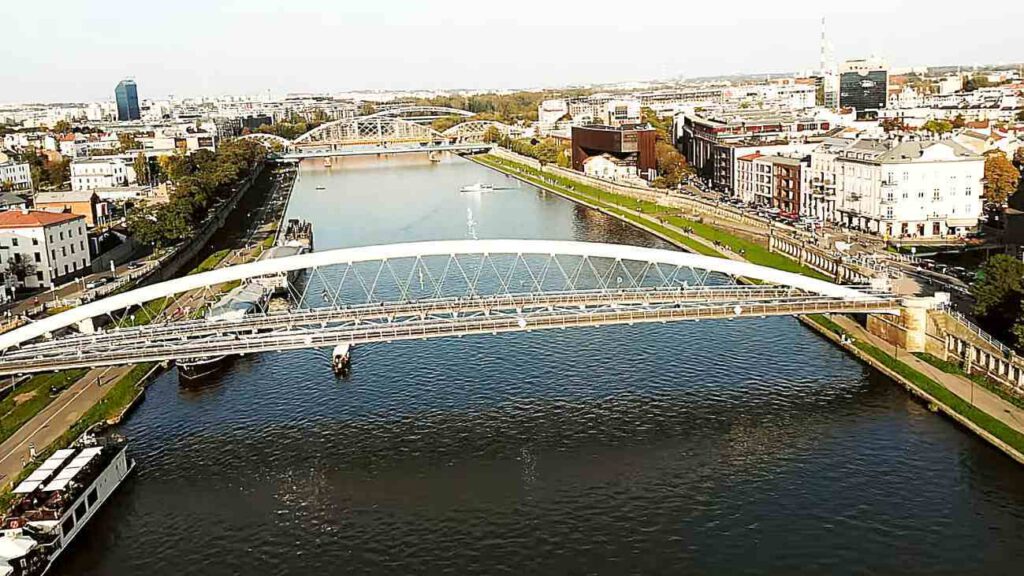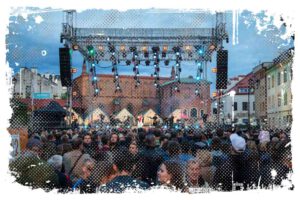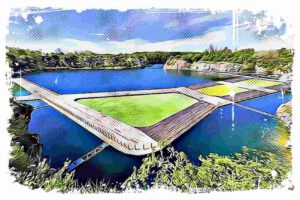One of the must-see places is Kazimierz – the historic Jewish quarter in Kraków. Tragically, the Holocaust slashed down Krakow’s Jewish community, which once made up 26% of the city’s populace. Imagine, before the war, from a population of over 780,000, more than a quarter were Jews.
Today, only a handful remain. The post-war years left Kazimierz in despair, with many buildings neglected and on the brink of falling apart. Fast forward to today, it’s clear that Kazimierz has dusted off its past. The area is revived and flourishes once again.
If you want a reason, it’s the Jewish Culture Festival. This event lured artists and global visitors, acting as a catalyst for the district’s transformation.

Kazimierz Jewish Quarter – The Deep Roots
In the old days, Kazimierz used to be an island separated from Krakow by the Vistula River. King Casimir the Great, looking for a way to fortify the capital, decided to establish a new city right there.
↳ Make sure to read my guide to the most amazing places to stay in Kraków:
How to Find Best Place to Stay in Krakow Old Town – Your Guide

It was under his reign that the city walls, towers, and gates started to rise. Think about how stunning these twin cities would have been in the Middle Ages!
Kazimierz isn’t just known for its old walls, it’s also a significant place in Jewish history. Due to the rising conflicts and intolerance in the 15th century, King John Albert decided to relocate Jews to Kazimierz, creating a separate district enclosed by a wall.

And there you go, this move gave birth to a new cultural hub for Jews, attracting some of the finest minds – scientists, writers, and politicians. Fast forward to the 19th century, Kazimierz was merged into Krakow, with its dividing walls brought down. The Vistula was filled in, paving the way for Dietla Street.
Kazimierz Quarter during World War II – The Dark Side
During the World War II, the Germans forced the Jews in Krakow to relocate to the ghetto in Podgórze district, located on the opposite side of the Vistula. This was the time when synagogues, cemeteries, and other Jewish landmarks faced destruction, and later served menial purposes like warehouses and stables.
From the thriving community of 60,000 Jews making up one third of Krakow’s populace, the majority were brutally exterminated by the Nazis. Post-war, Kazimierz was left abandoned, its vibrant streets and buildings forgotten.
Many older Krakow residents still recall Kazimierz as a dilapidated, slightly dangerous part of the city, inhabited by the less affluent. But guess what, those gloomy days are over. Kazimierz, with its unique aura, has been pulling in artists, locals, and of course, tourists.
In fact, the visitor count here can even challenge the Old Town. I am convinced, when it comes to cafes, clubs, and restaurants, Kazimierz surely takes the lead.

Kazimierz Jewish Quarter Attractions – Your Tour Guide
I’ve got a tour of Krakow’s Kazimierz lined up for you. It’s not just about Jewish landmarks, but also amazing churches and charming streets. And don’t forget to wander off on your own. You’ll find lots of hidden gems.
Sure, some folks start their tour from Stradomska or Starowiślna streets, but I suggest a different route. Let’s begin with a stroll from Wawel along the Vistula bank. You’ll reach the spot where Kazimierz started.
Church on the Rock – Basilica of St. Michael the Archangel and St. Stanislaus the Bishop and Martyr
This is one of the most crucial churches in Krakow, maybe even in Poland. Legend says it started as a pagan temple, later turned Christian. Here, Saint Stanislaus, one of Poland’s patrons, supposedly met his end.
In the basement, you’ll find the Crypt of the Meritorious, the final resting place of famous Poles like Jan Długosz and Czesław Miłosz.
After exploring the church, if you’re tired, head down Piekarska Street to Wolnica Square. If you still have energy, I suggest you keep walking along the river. You’ll pass by the baroque Holy Trinity church and reach the Father Bernatek footbridge. Don’t cross it – instead, turn left to the city, onto Mostowa Street.

A Stroll Down Mostowa Street
With the Father Bernatek footbridge connecting to Podgórze, Mostowa Street has seen a revival. The street is now full of cafes and restaurants, perfect for a pitstop. The buildings here date back to the 19th century.
Interesting fact: Mostowa got its name from an old bridge to Podgórze, demolished in 1925. (Most means Bridge)
At the end of Mostowa, you’ll find Wolnica Square. Its name comes from „Forum liberum”, which refers to the right to sell meat outside stalls.
Kazimierz Town Hall – Ethnographic Museum
Standing tall on Wolnica Square is the Ethnographic Museum building, which was once the Kazimierz town hall. Constructed in 1414, the building has undergone several changes over the years. Although Kazimierz lost its city status, the museum retains old walls and historical paintings, which are worth seeing.
Once upon a time, Wolnica Square was Kazimierz’s main market. Today, it might seem empty, but sometimes it hosts cultural events. From the square, you can’t miss the imposing, brick church building. Guess what, that’s our next stop 🙂
Corpus Christi Church
This is the main parish church of Kazimierz, a creation of King Casimir the Great. It’s one of the most stunning buildings in the city, blending Romanesque, Gothic, and Baroque styles. The tall columns, chapels, and especially the 17th-century altar will catch your eye. A monastery is right next to it.
The Industrial St. Warzyniec Street
For tech buffs, St. Warzyniec Street is a must-visit. This area was the industrial heart of Krakow in the 19th century. It had a tram depot, a gasworks, and a power plant. Now, these buildings are part of the Krakow Technology Trail. The old depot houses the Municipal Engineering Museum, a treat for both kids and adults.

After visiting the museum, we’ll move onto Wąska Street. This corner, known as Judah Square, serves yummy street food from cars and stalls. Perfect for a sunny day. Plus, street art enthusiasts will find the neighboring streets exciting. Now, we’re entring the heart of Kazimierz for a quick wander.
Jozefa Street
Jozefa Street is one of the most atmospheric streets in Krakow. It’s packed with cafes, galleries, interesting stores, and antique shops. This place has a unique Krakow vibe you won’t find at the Main Market Square.
Be sure to visit the gate at the Stable Pub. Here, you’ll get a look at typical Kazimierz buildings from the inside. After exploring the Stable, check out the Mleczarnia pub on Meisels Street. Take a right from there, and you’ll reach the famed:
The Vibrant New Square (Plan Nowy)

At the heart of Kazimierz’s nightlife, New Square is bustling with clubs, restaurants, and cafes. The place transforms when the clock hits 20:00! You’ll find a round table in the middle of the square, serving up famous casseroles from its windows.
Perfect for a break between events! Now, which windpw makes the best casserole? That’s for you to decide. Any time of day or night, it’s worth to sit in one of the pubs.

During the day, fruit and vegetable sellers set up shop. On Saturdays, there’s a flea market (more for tourists). I, however, prefer the one at Hala Targowa. From New Square, let’s stroll down Estery Street to:
Tempel Synagogue
This was a Reform Judaism temple before World War II, which leaned towards cultural assimilation. Services here were shorter and had organ music, almost church-like. The architecture and decor have Christian church elements.
Now, Tempel hosts Jewish services and cultural events. It’s one of the few places where Jewish services are still held. The Jewish Community Center is right next to it.
We’ll head down Miodowa Street towards Starowiślna. Miodowa has an increasing number of cool pubs. You can also take a detour to Warszauera Street to visit:
Kupa Synagogue
This is the main synagogue of the Krakow Jewish community, built in the 17th century. It was funded by donations. „Kupat tzedakah” means sacrificial box, hence the name. From the outside, it might not look like much, but its colorful interior is filled with early 20th-century paintings.
Interesting fact: There are four more layers of paintings underneath, the oldest from the 17th century. Now, we can amble through small streets or along Miodowa Street to Szeroka. We're in the heart of historical Jewish Quarter of Kazimierz.
New can stroll to Szeroka via quaint streets or Miodowa Street. Welcome to the historical Jewish heart of Kazimierz!
Old Synagogue – A Glimpse into the Past

Next on our itinerary is the Old Synagogue, perched atop Szeroka Street. It’s perhaps the oldest in Poland, dating back to 1407. Built by Czech Jews, this orthodox two-nave building was initially for men only.
The Old Synagogue underwent numerous renovations and rebuilds. Until 1939, it was the religious and cultural epicenter for the Krakow Jewish community.
Now, the Old Synagogue houses a branch of the Historical Museum of Krakow – History and Culture of Jews. The war left its scars on this synagogue, causing it to lose its original splendor. It was devastated completely, stripped of its liturgical equipment and the invaluable library gathered by the community over centuries.
Behind the Old Synagogue, you’ll find remnants of Kazimierz’s old city defensive walls. The streets beyond it are also worth exploring. At this point, you could wrap up your sightseeing and lose yourself in Kazimierz’s labyrinth of courtyards. But, if Jewish culture intrigues you, Starowiślna behind Starowiślna is worth a visit.
New Cemetery – Echoes of a Bygone Era
Founded in 1800 after Remuh’s closure, the New Cemetery is still an active Jewish burial ground. You might be taken aback by the condition of Jewish cemeteries. But it is worth to say that this is a culture with its own customs.

The tombstones were vandalized during the war (some were even used as paving slabs). Furthermore, the families of those interred here are likely long gone, leaving the cemeteries in less than perfect shape.
Street Art in Kazimierz Quarter

As You have already seen, polish Jews haven’t been forgotten. Their memories thrive even on the walls of Polish buildings through murals – large-scale paintings that breathe life into the bricks.
These murals stand proud in towns and cities where Jews were once an integral part of the community before World War II. Urban activists, with the aim of reviving the memory of their Jewish neighbors, commission these artworks. It is worth to say that these murals form a silent, yet profound bridge between Poles and Jews.

Pil Peled, an artist, breathed life into a mural known as Judah on Wawrzyńca 14, Krakow. His design references the new logo of the Jewish Culture Festival – the Lion of Judah. Pil Peled says:
A child is a small, terrified nation. Combined with the lion – a symbol of strength – it resembles the eternal struggle of the Jews. The mural also reveals the child in each of us. It makes you aware of the need to fight your own fears. Judah symbolizes strength and righteousness. Judah gave a name to all Jews.
The Bosak Family – A Tale Told in Paint
A stroll down to Bawół square, Krakow brings you face to face with a striking mural dedicated to the Bosak family. Once the owners of the tenement house upon which the mural stands, the Bosaks called it home since the seventeenth century. They relocated to Israel after the war and still reside there.
Before the war, the Bosaks were one of Poland’s wealthiest families. A professor notes that their history in Krakow’s Kazimierz, as the largest wholesalers of iron and kitchen utensils in Galicia, is narrated in a book by Aleksander Skotnicki.
The Bosaks were merchants, craftsmen, with roots tracing back to Anszel Bosak. His son, Józef, was a pipe manufacturer, and Józef’s son, Lipa Bosak, founded a company dealing in iron goods. During the January Uprising, insurgents from the Kingdom of Poland procured weapons from him, landing him in trouble with the Austrian authorities.
One surviving member of the family, Mark Bosak (1912-1997), was the confidant of Oskar Schindler, who shared a closely-guarded secret with him. Schindler had been awarded the Blut Orden, or Order of the Blood, a high honor given for exceptional services to the Nazi Party and its leader, Hitler.
Schindler received this due to his efforts as a spy that led to his capture by the Czechs with plans for Czech fortifications, sentencing him to death. His survival resulted in Hitler honoring him with the Order of the Blood, allowing him to contribute to the salvation of approximately 1200 Jews.
And now, having given you these glimpses into the rich tapestry of Kazimierz’s history and culture, I hope you can immerse yourself in the unique atmosphere of this district. Enjoy your journey!
References:
- https://podroze.onet.pl/ciekawe/dlaczego-kazimierz-jest-najfajniejsza-dzielnica-krakowa/cv9d7nq
- https://pl.wikipedia.org/wiki/Kazimierz_(Krak%C3%B3w)
- https://www.krakow.pl/odwiedz_krakow/1362,artykul,zydowski_kazimierz.html




